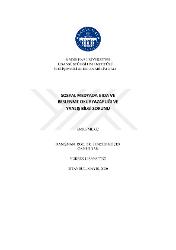| dc.contributor.author | Meriç, Emre | |
| dc.date.accessioned | 2021-08-01T10:19:59Z | |
| dc.date.available | 2021-08-01T10:19:59Z | |
| dc.date.issued | 2020 | |
| dc.identifier.uri | https://hdl.handle.net/20.500.12469/4125 | |
| dc.description.abstract | İnternet teknolojilerindeki gelişmeler ile birlikte ortaya çıkan sosyal medya, kamu sağlığı enformasyonunun geniş kitlelere iletilmesinde önemli bir kaynak haline gelmesinin yanı sıra doğrulanmamış ve yanıltıcı sağlık bilgisinin de yayılım hızını artırmıştır. Sosyal medyada yalan ve yanlış bilgi üzerine yapılan araştırmalarda da yanlış bilgilerin gerçeklerden "daha hızlı, daha derin ve daha geniş" yayıldığı görülmüştür. Gıda ve beslenme konusunda içerik tüketimine medya okuryazarlığı bağlamında bakış açısı getiren bu çalışmada, Türk sosyal medya kullanıcılarının gıda ve beslenme konulu içeriklerde doğru bilgi ve yanlış bilgiyi anlama, yorumlama ve değerlendirme süreçlerini ele almaktadır. Çalışmada niceliksel ve niteliksel verileri toplamaya, analiz etmeye ve birleştirmeye imkân veren karma yöntemden yararlanılmıştır. Çalışmada içerik analizi, medya günlüğü ve derinlemesine mülakat teknikleri üçleme şeklinde kullanılmıştır. Çalışmanın sonucunda ise sosyal medyada gıda ve beslenme konusunda yanlış bilgiler paylaşıldığı, içeriklerde kaynakça kullanılmadığı ve kadın bedeninin metalaştırıldığı görülmüştür. Medya kullanıcılarının gıda ve beslenme enformasyonlarının doğruluğunu ve yanlışlığını farklı bir şekillerde yorumladıkları ve değerlendirdikleri tespit edilmiştir. Kullanıcıların gerek geliştirmiş oldukları teyit mekanizmalarının gerekse içeriği anlamlandırma biçimlerinin kullanıcıların paylaşım motivasyonlarını ve yanlış bilgiye gösterdikleri tepkileri farklılaştırdığı görülmüştür. Anahtar Sözcükler: sosyal medya, gıda ve beslenme, yanlış bilgi, okuryazarlık, medya okuryazarlığı | en_US |
| dc.description.abstract | Social media, which emerged with the advances in internet technologies, has become an important source in the transmission of public health information to large masses, as well as increased the speed of dissemination of unconfirmed and misleading health information. In social media researches on false health information, it was seen that false information spread "faster, deeper and broader" than the facts. In this study, which brings a point of view to content consumption in the context of media literacy in food and nutrition, it deals with the processes of understanding, interpreting and evaluating the true information and false information in relation to food and nutrition contents. In this study, a mixed method that allows to collect, analyze and combine quantitative and qualitative data was used. Content analysis, media dictionaries technique and in-depth interviews were used as triangulation. As a result of this study showed that the false information about food and nutrition was shared on social media, the references were not used in the contents and the female body was commodified. This study showed that media users interpret and evaluate the falseness and trueness of food and nutrition information in a different way to the extent of their media repertoire. Lastly, this study showed that confirmation mechanisms developed by the users and the way they make sense of the content differentiate the sharing motivations of the users and their reactions to the misinformation. Keywords: social media, food and nutrition, misinformation, literacy, media literacy | en_US |
| dc.language.iso | tur | en_US |
| dc.publisher | Kadir Has Üniversitesi | en_US |
| dc.rights | info:eu-repo/semantics/openAccess | en_US |
| dc.subject | N/A | en_US |
| dc.title | Sosyal medyada gıda ve beslenme okuryazarlığı ve yanlış bilgi sorunu | en_US |
| dc.title.alternative | Food and nutrition literacy in social media and the problem of false information | en_US |
| dc.type | masterThesis | en_US |
| dc.department | Enstitüler, Lisansüstü Eğitim Enstitüsü, İletişim Bilimleri Ana Bilim Dalı | en_US |
| dc.institutionauthor | Meriç, Emre | en_US |
| dc.relation.publicationcategory | Tez | en_US |
| dc.identifier.yoktezid | 648662 | en_US |
















